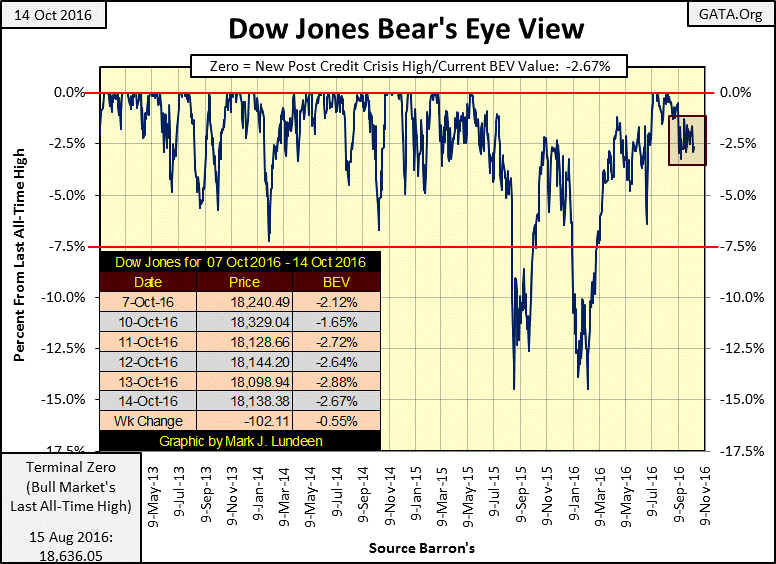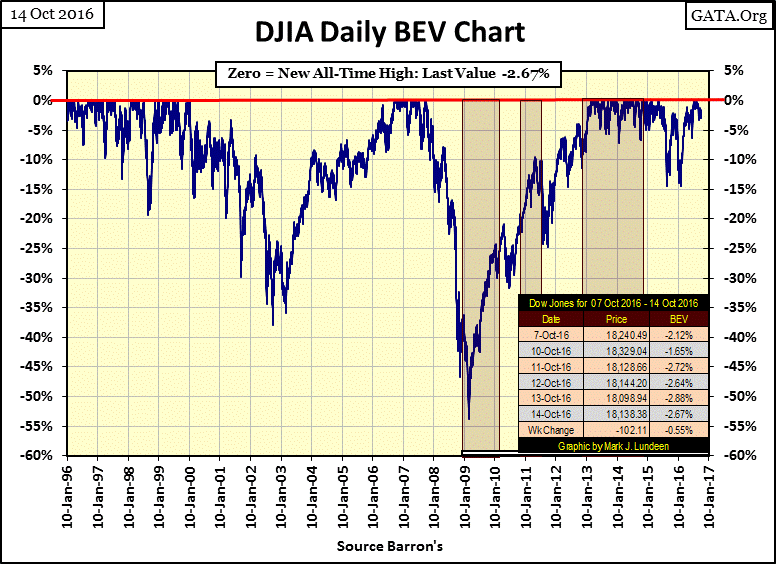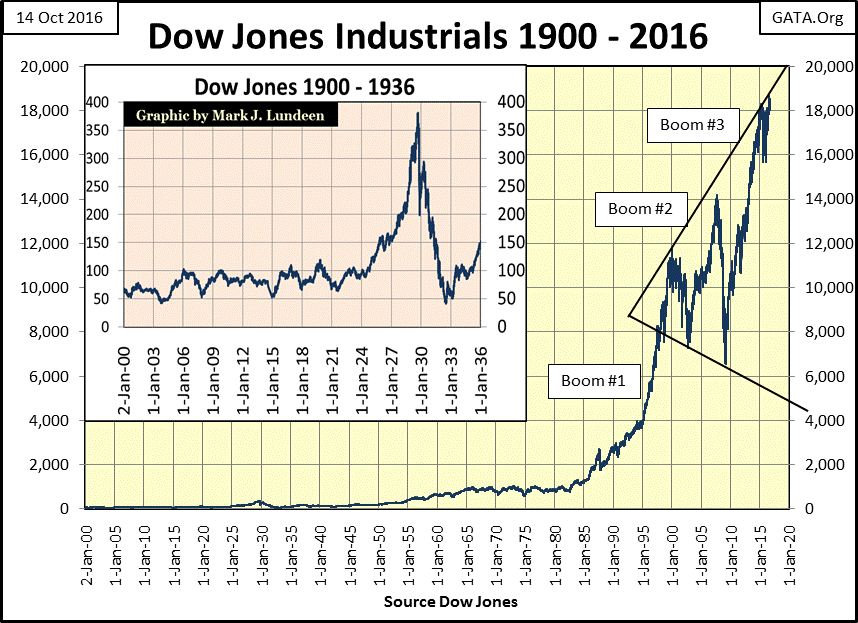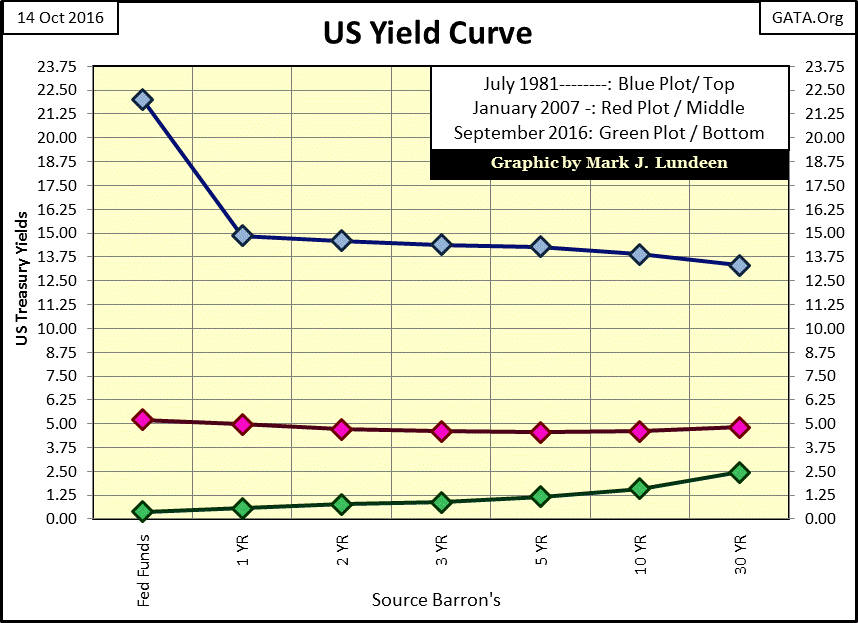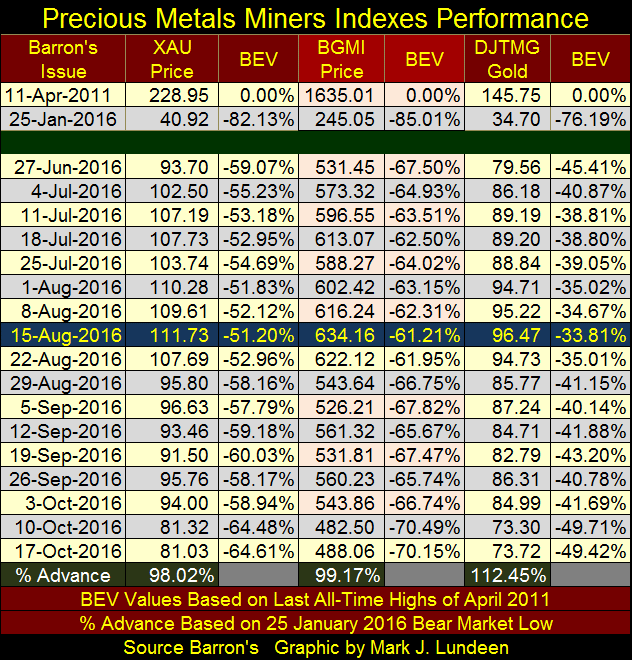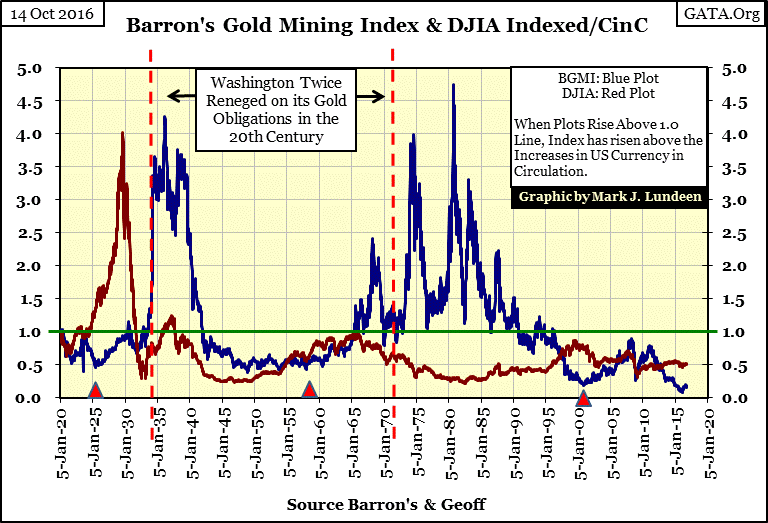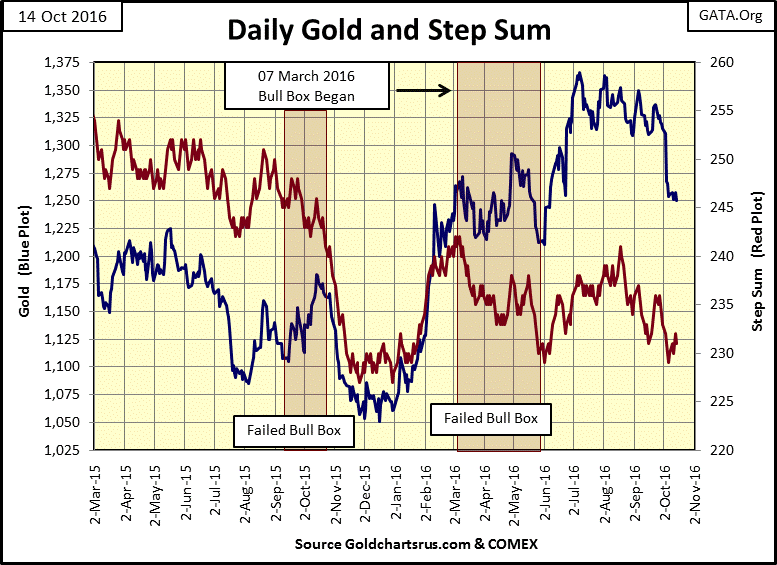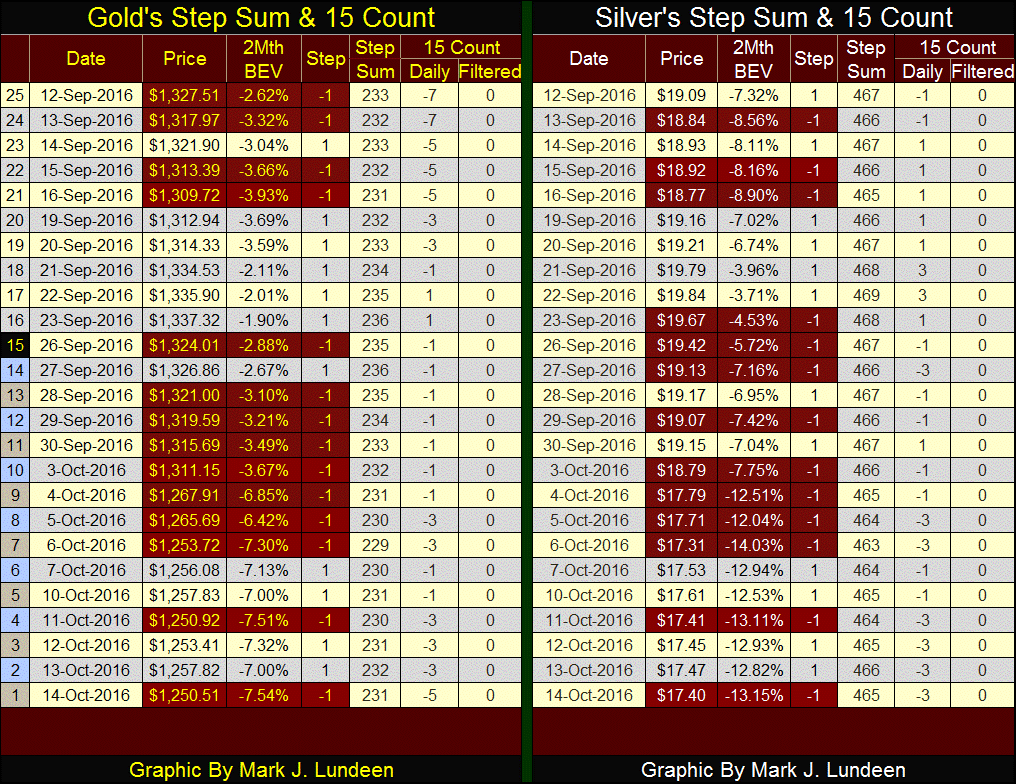Market Update For The Second Week Of October
The box in the BEV chart below contains the Dow Jones Index since the first week of September. With the presidential election so near, it’s not surprising the market hasn’t done much of anything as our “regulated” markets are being managed for the benefit of our very corrupt, incumbent-political class. But it makes for boring market commentary and writing about it tedious.
Obviously the “policy makers” either can’t make, or more likely fear to inflate the stock market’s valuation higher, so they do the next best thing and prevent it from going down. So, they have been doing exactly this for the past seven weeks. For the stock market, as well as everything else, I expect this will be the case until after the November 8th presidential election. Most likely that will prove to be so for gold and silver too.
Here’s a longer term BEV chart for the Dow Jones. The 38% high-tech and the 54% credit-crisis bear markets are easy to identify. I highlighted Dr. Bernanke’s three episodes of QE in the chart, and for the bulls what a wonderful tonic they proved to be from the depths of the second greatest Dow Jones bear market since 1885. With the good doctor’s programs of QE, the Dow Jones recovered from its sub-prime mortgage bottom quicker than it did its much less severe high-tech bottom. That plus after it recovered to new all-time highs (BEV Zeros), the Dow Jones saw many more new BEV Zeros in the chart below during the post credit crisis recovery than during the post high-tech recovery.
However, since the FOMC stopped their QE3 program almost two years ago, other than not having Mr Bear clawing back their capital gains, stock market bulls haven’t had much to cheer about since May of 2015.
Next is a dollar chart for the Dow Jones Index going back to 1900 showing a troublesome similarity between the Dow Jones from post WW2 to present, and that from the years of 1900 to 1936. From 1900 to 1925 the Dow Jones was range bound between 50 and 125, and then thanks to monetary inflation flowing from the Federal Reserve, the Dow Jones soared to 380 in just four years. It was only a bubble that was fated to deflate during the Great Depression, taking the Dow Jones below where it was in 1903.
Looking at the current bubble in the stock market, we see not one but three booms. Only the high-tech and sub-prime bubbles have so far seen their busts. To believe that the third inflationary boom will escape from its deflationary bust is very naïve in my opinion.
The “policy makers” are on record they were practicing bear-market interruptus during the high-tech and sub-prime mortgage declines. So, it’s safe assuming the 38% decline in 2002 and the 54% decline of 2009 would have been deeper had they left Mr Bear alone to do his job; removing Wall Street’s garbage assets from everyone’s balance sheet, and excess market valuations for the viable assets that remained.
When looking at the chart above two questions come to mind;
- Can the “policy makers” once again implement a program of bear-market interruptus to moderate the pending market decline?
- If not, how far is the Dow Jones fated to decline?
To the first question; I don’t doubt the “policy makers” will attempt to fight any significant market decline by “injecting liquidity” into the financial system. But since January 2000, the top of the high-tech bubble, with each attempt to oppose a bear market decline, the makers of policy, and their banking systems have grown weaker as Mr Bear has grown stronger.
The “policy makers” know this. Their inability to normalize interest rates and bond yields from their current historic lows to where they were before January 2007 proves that (chart below). Apparently, even a 100 basis point upward shift over the entire yield curve could very likely bankrupt the global banking system; and that is never good for financial asset valuations!
So, to answer the second question; how far is the Dow Jones fated to decline? Well, your guess is as good as mine. But I expect the next significant market decline will be as historic as seen during the Great Depression, possibly taking the Dow Jones below where it was at the beginning of the August 1982 - January 2000 bull market: 776.92. In past articles I’ve used the Dow Jones dividends to prove this is entirely possible.
On Friday, the Dow Jones was paying out $470 in dividends and yielding 2.59%; fixing its close at the end of the week at 18,138.38. Currently the Dow Jones is paying out a historic amount of cash to investors. Given that corporate America has taken full advantage of the cheap funding provided by the Federal Reserve to borrow many trillions in the bond market to fund their share buyback programs, the Dow Jones current payout is at risk of significant reductions when the economy enters a turndown. Its current yield of 2.59% will also increase when interest rates and bond yields break free from their current “policy” lock down.
In the table below we can fix the valuation of the Dow Jones with its dividend payout and yield. A 36% reduction in payout to $300 and an increase in yield to 6%, both conditions well within historical possibility, would take the Dow Jones down to 5000; resulting in a 73% bear market decline.
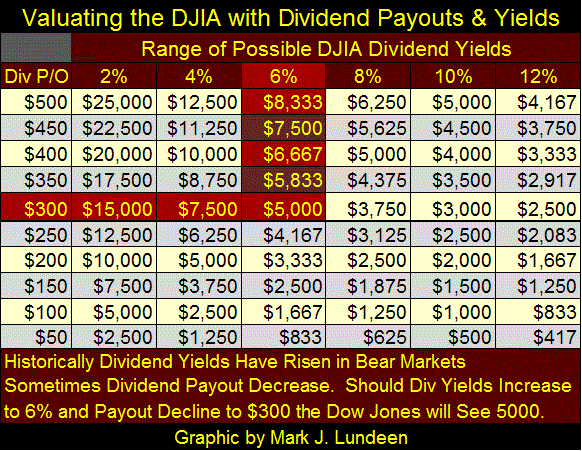
But considering how American business, markets and the political leadership has been managed these past few decades, I believe seeing the Dow Jones declining by only 73% in the years to come will prove to be optimistic. So when is this catastrophic decline to happen? Obviously not before the November elections.
Moving on to the gold and silver mining stocks, it seems their corrections from their August peak is nearing their end point. We could see further declines from here, but I think the worst of the correction is over.
Since 1920, the gold miners have traditionally proven to be a great counter-cyclical investment during bouts of deflation in the financial markets. I anticipate that once again they will prove to be so in the next deflationary bear market.
Here’s a chart displaying the Dow Jones (Red Plot) and the Barron’s Gold Mining Index (Blue Plot) as a ratio to Currency in Circulation (CinC).
The only Dow Jones bull market that outperformed inflation as measured by CinC (paper money and coins circulating in the economy) occurred in the 1920s; almost a hundred years ago. The BGMI bull markets of the 1930s outperformed the Dow Jones bull market of the 1920s, and did so again from 1965 to 1995. But, and this is a * BIG BUT *; only if investors purchased the gold and silver miners when the blue plot was below the 1.0 line. To do otherwise invited massive losses. As it is now, in terms of CinC inflation, the gold and silver miners are at lows not seen in the past century, and so are compelling bargains at today’s prices.
There is an old market saying that is rarely spoken anymore; when it’s time to buy Wall Street never rings a bell to notify investors. The same can be said for when investors should be selling. So, if your waiting for the majority of “market experts” on CNBC to tell you to lighten up on today’s glamor stocks and use the proceeds to buy the gold and silver miners, that’s not going to happen until the stock market is much lower, and the miners much higher.
Below is gold with its step sum. The big decline of late September / early October is painfully evident. However, for the past two week the price of gold has so far refused to break below $1,250. It may yet do so, but gold still far above its lows of last December.
Don’t get me wrong, seeing gold take the big hit it saw in the past few weeks didn’t boost my moral any more than yours. But in the past two decades these declines are almost always from Wall Street flooding the COMEX gold and silver market with insincere promises to deliver metal these banks don’t have sometime in a future that never arrives. If the futures market’s regulators refuse to put a stop to this obvious scam, a day is coming when market demand for actual precious metal will.
Here’s gold and silver’s step sum and 15 count table. Since the end of August their 15 counts have been negative, indicating more trading sessions in a fifteen day sample with the metals closing down than up. Historically, the best time to buy is when a market is in a funk. For the old monetary metals and their miners, this is a pretty funky market.
As there isn’t much going on in the markets, I’m going to take a break as it’s hard finding something new and interesting to write about. I plan to send out my next article on the second weekend of November. Hopefully Donald Trump wins the coming election, because if crooked Hillary wins – well, I don’t even want to think about that.
Mark J. Lundeen






